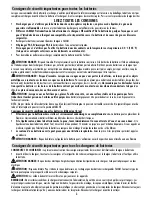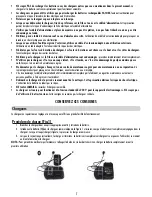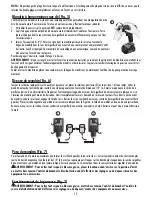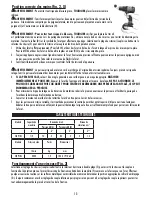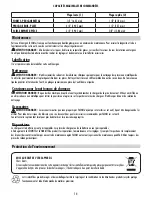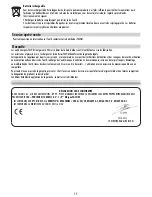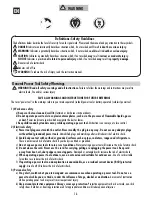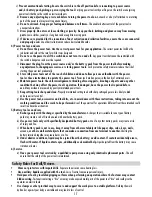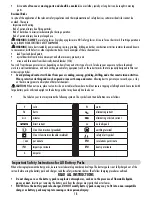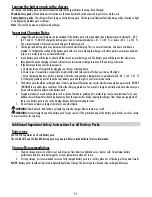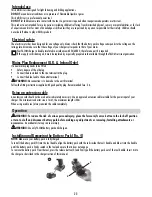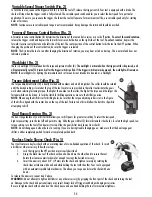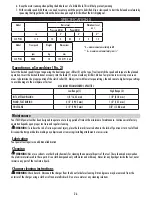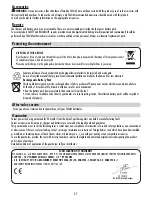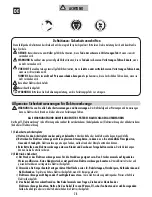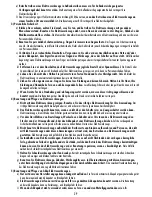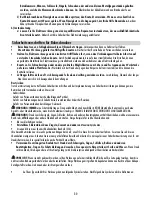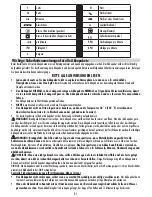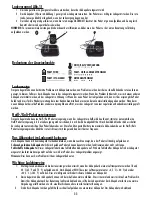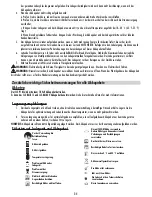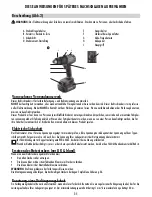
20
•
Do not operate charger with damaged cord or plug -
have them replaced immediately
.
•
Do not operate charger if it has received a sharp blow, been dropped, or otherwise damaged in any way.
Take
it to an authorized service centre.
•
Do not disassemble charger; take it to an authorized service centre when service or repair is required.
Incorrect reassembly may result in a risk of electric shock, electrocution or fi re.
• In case of damaged power supply cord the supply cord must be replaced immediately by the manufacturer, its service agent or
similar qualifi ed person to prevent any hazard.
•
Disconnect the charger from the outlet before attempting any cleaning. This will reduce the risk of electric shock.
Removing the battery pack will not reduce this risk.
•
NEVER
attempt to connect 2 chargers together.
•
The charger is designed to operate on standard 230V household electrical power. Do not attempt to use it on any
other voltage.
This does not apply to the vehicular charger.
SAVE THESE INSTRUCTIONS
Chargers
This charger requires no adjustment and is designed to be as easy as possible to operate.
Charging Procedure (Fig.1)
1. Plug the charger into an appropriate outlet before inserting battery pack.
2. Insert the battery pack (H)
into the charger, as shown in Figure 1, making sure the pack is fully seated in charger.
The red (charging) light will blink continuously indicating that the charging process has started.
3. The completion of charge will be indicated by the red light remaining ON continuously. The pack is fully charged and may be used at
this time or left in the charger.
NOTE :
To ensure maximum performance and life of Li-Ion batteries, fully charge the pack before fi rst use.
Indicator Light Operation
Charge Indicators
Some chargers are designed to detect certain problems that can arise with battery packs. Problems are indicated by the red light fl ashing at a
fast rate. If this occurs, re-insert battery pack into the charger. If the problem persists, try a different battery pack to determine if the charger
is OK. If the new pack charges correctly, then the original pack is defective and should be returned to a service centre or other collection site
for recycling. If the new battery pack elicits the same trouble indication as the original, have the charger tested at an authorized service
centre.
Hot/Cold pack delay
Some chargers have a Hot/Cold Pack Delay feature: when the charger detects a battery that is hot, it automatically starts a Hot Pack Delay,
suspending charging until the battery has cooled. After the battery has cooled, the charger automatically switches to the Pack Charging mode.
This feature ensures maximum battery life. The red light fl ashes long, then short while in the Hot/Cold Pack Delay mode.
PACK CHARGING
PACK CHARGED
HOT/COLD DELAY
PROBLEM PACK OR CHARGER
PROBLEM POWERLINE
H
Summary of Contents for CL3.P18S
Page 117: ...117 1 2 RCD RCD EL...
Page 118: ...118 3 off on 4 5...
Page 119: ...119 6 CCA V W watt Hz hertz min no I I min RPM IPM BPM A...
Page 120: ...120 FACOM 40 C 105 F on li ion 15 FACOM...
Page 121: ...121 FACOM 2 230V 1 1 2 H 1 3 H...
Page 122: ...122 1 18 24 C 65 F 75 F 4 5 C 40 F 40 5 C 105 F 2 3 4 18 24 C 65 F 75 F 5 6...
Page 124: ...124 FACOM EN 60335 FACOM 3A 1mm2 30 FACOM D C A F 2 E B G H E I...
Page 125: ...125 4 H G 2 A 2 B OFF 2 C D 20 3 D 3 E 4 H G D E 3...
Page 126: ...126 5 1 OFF 2 3 19 3 4 2 OFF 6 D E 1 6 4 1 4 Torx 6 7 6 4 1 4 off off 5 6 7 E D E D...
Page 142: ...142 CL3 BA1830 CL3 CH1018...

